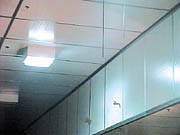
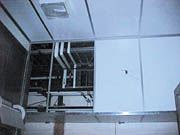
Nobody knows that better than the people at the Rich-Sea Pak plant, of Brunswick, Ga. The processor of frozen fish and seafood handles millions of pounds of product a year, supplying a variety of foods to some of the country’s largest fast-food restaurant chains and retail outlets. In addition to contamination inherent to the preparation of the seafood, ceilings in the plant are continually exposed to extreme temperature, both hot and cold.
When it was time for the plant to modernize its lines recently, it looked for a ceiling system that could withstand the conditions in the plant and a thorough—sometimes daily—washing, and come out clean enough for another demanding day of production.
“The major factor in choosing the system was from a sanitation and food safety standpoint,” says Art Christianson,
general manager of Rich-Sea Pak.
The old ceiling was frequently cleaned, he is quick to point out. But the ceiling system previously in place required laborious hand cleaning, a “constant maintenance issue” for the plant.
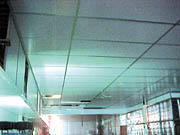
The right ceiling
The new suspended-ceiling system, the FCW Gridlock System, is now completely in place at the plant’s Line One and spans 12,000 square feet of production space. Planned for two more production lines, the ceiling has saved the plant manpower and lost time, as well as provided more effective cleaning, Christianson says.“Our system is more sanitary than most because it was specifically designed for food and beverage facilities where they need a sanitary ceiling that they can periodically wash, or even hose, down,” says Paul Sorgi, vice president of FCW Technologies.
The custom panels are sealed with a special silicone rubber cement.
“When the panels are sealed in place with the proper light fixtures, it can be hosed down to 200 psi,” he explains.
The key to the system is the design of its cross T’s. While the standard ceiling grid requires a number of clips to hold the grid pieces together, the FCW Gridlock ceiling system utilizes cross T’s that the installer rotates about 45 degrees to lock the grid in place without the use of additional fasteners. Sorgi describes the grid as very heavy-duty aluminum, compared to some systems.
“What we liked about the FCW grid was that the installation method provided a snap-lock system that resulted in a more rigid installation,” says Brian Kappele, project manager for the Stellar Group, of Jacksonville, Fla., and general contractor on the project. “What you’d find in the past was a system that didn’t always keep itself square because it wasn’t so rigid.”
“The grid has a good lock-together format to it,” says Randy Wulf, president of Easy Care Environs Inc., of Olympia, Wash. “Once you get it up there and it’s all locked together, it’s going to take quite a bit to yank it down, unlike standard stainless steel or steel grid systems that you can just kind of grab the grid and pull it out.”
Christianson says the system is so strong that, “There are areas you can walk or crawl on it. A person can get on top of it and be working.”
In fact, one of the reasons the FCW Gridlock System was specified at Rich-Sea Pak is that it can be designed with overhead access in mind. FCW Technologies custom-manufactured specially sized insulated panels to fit a 4-foot-by-8-foot grid for this project.
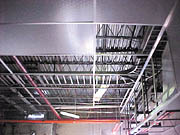
Future access
Sorgi explains that most food and beverage processing facilities have a lot of overhead pipes, wiring and even equipment above the ceiling level. Periodically, maintenance people and other workers have to access the area for repairs or equipment replacement.“As you can imagine, the 2-foot-by-2-foot panel, or 2-foot-by-4-foot panel doesn’t allow easy access to the ceiling,” he says. “By using a 4-foot-by-8-foot panel, one or two people can easily work in that 32-square-foot area just by removing that one panel.”
In fact, using just a hand drill and a saw, Sorgi says, in-plant personnel can easily install the system. They can also quickly remove the FCW Gridlock System fiberglass panels by breaking the seal with a putty knife, and can replace and reseal the panels with silicone sealant. A single-sided foam gasket or strip can be used where panels must be removed on a regular basis for access to overhead valves or other equipment.
“That’s a nice advantage,” he says. “It makes it a lot easier to access utilities overhead.”
Easy removal and replacement also makes the system practical for situations where utilities or equipment must be retrofitted.
“Say you have to put a big tank in the ceiling,” says Sorgi. “You could very easily remove a large section of the ceiling, install the equipment, and then re-install the grid with no damage to the grid, and no compromising the integrity and durability of the system.”
This grid design also enabled the Rich-Sea Pak plant to incorporate a unique configuration of running pipe in duct chases along its walls.
“Our system is designed so you can put in a bulkhead or drop a vertical panel down and then go to the wall to create a space where you can run these utilities,” says Sorgi. “That makes for a much cleaner ceiling. Many food and beverage facilities have pipes penetrating the facility throughout the entire ceiling area. What they did in this case was to run them all along one area, and then had them come out through that. The pipes were then covered vertically, using the ceiling product as a wall in this case.”
In the final analysis, all involved agree the use of the FCW Gridlock system on the Rich-Sea Pak project was a success.
“The plant is very happy with the system,” says Kappele. “It worked out well. It was a good job.”

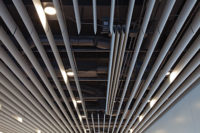
Report Abusive Comment